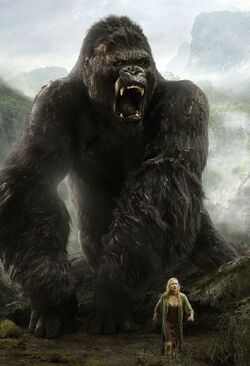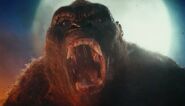| King Kong | |||
|---|---|---|---|

| |||
| Naming | |||
| Others | Kong Eighth Wonder of the World | ||
| Binomen | Megaprimatus kong | ||
| Morphology | |||
| Body type | Gorilla | ||
| Average height | 50 feet (King Kong 1933 and King Kong 1976 to King Kong Lives) 147.6 feet (King Kong vs. Godzilla) 65.6 feet (King Kong Escapes) 25 feet-32 feet (King Kong 2005) 104 feet (Kong: Skull Island to present) | ||
| Average weight | 5 tons (King Kong 1933) 20-60 tons (King Kong 2005) 27,557.8 tons (King Kong vs. Godzilla) 1,102.3 tons (King Kong Escapes) 158 tons (Kong: Skull Island) | ||
| Intelligence | |||
| Sentience | Sentient | ||
| Sapience | Semi-sapient | ||
| Aggressivity | Medium to High | ||
| Ecology | |||
| Place of origin | Earth | ||
| Habitat | Skull Island Farou Island | ||
| Diet | Omnivorous | ||
| Locomotion | Knuckle-walking, Bipedal walking | ||
| Related species | Kiko (Son) Kong Junior (Son) (in King Kong Lives) | ||
| Status | Extinct Alive | ||
| Behind the Scenes | |||
| Universe | King Kong Godzilla Monsterverse | ||
| Created by | Merian C. Cooper | ||
| Performed by | Shoichi Hirose (King Kong vs. Godzilla) Haruo Nakajima (King Kong Escapes) Rick Baker (1976 Remake) Peter Cullen (Vocal effects for Kong in 76' Remake) Peter Elliot (King Kong Lives) Andy Serkis (2005 Remake) Lee Tockar (Kong: King of the Apes) Terry Notary (Kong: Skull Island) | ||
King Kong is a gigantic gorilla-like primate that lives on Skull Island.
Overview
In one of the versions of the story, Kong's species are probably not related to gorillas, though, and are more likely to be related to the extinct ape Gigantopithecus. They probably grew in size to be protected from predatory dinosaurs, such as Venatosaurus or Vastatosaurus rex. As the result of being killed by huge predators, storms, and earthquakes, the species has been declining leaving Kong the last of his kind.
In the 1933 film, The only individuals left were King Kong and his son, Kiko. While King Kong was shot off the Empire State Building in New York, Kiko was killed due to the flooding of Skull Island.
Notes
- The monster featured in Toho's 1962 classic King Kong Vs. Godzilla differs in all but name from its original Hollywood counterpart. For obvious reasons the Kong from that movie was scaled up to 45 meters, many times larger than either the 1933 or 2005 version. It also gained the ability to absorb energy from electric currents, and its native homeland was called Farou Island rather than Skull Island.
- Depends on any incarnation, Kong appears to be either a bipedal or a knuckle walking ape.
- In some versions, Kong could be originated from a fictitious species (Megaprimatus kong in the 2005 remake and an unnamed simian humanoid species in the "Monsterverse")
- Along with The Beast from 20,000 Fathoms, the original 1933 film has been the inspiration from film director, Ishiro Honda for his 1954 film, Godzilla.









